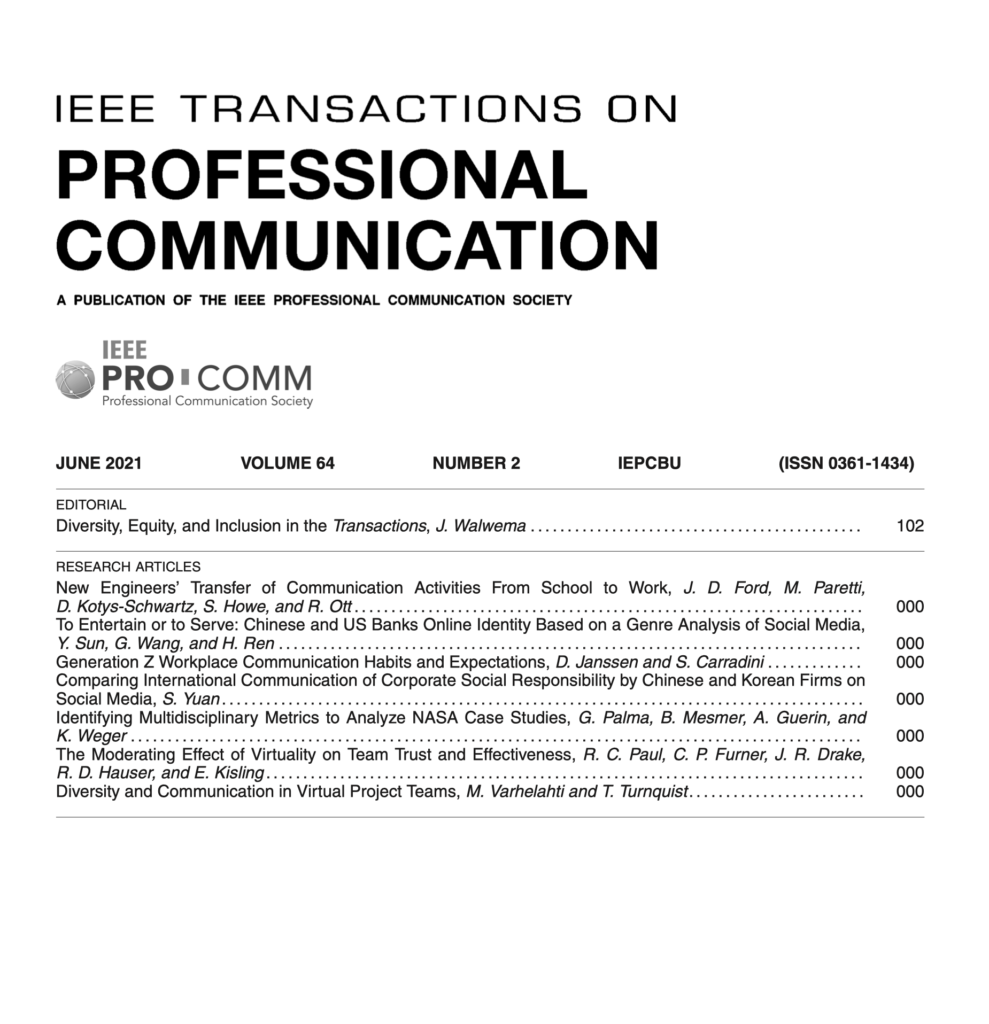The June 2021 of IEEE Transactions on Professional Communication is Now Available
Published on June 9, 2021

Volume 64, Number 2, June 2021
Research Articles:
New Engineers’ Transfer of Communication Activities from School to Work, by J. D. Ford, M. Paretti, D. Kotys-Schwartz, S. Howe, and R. Ott
Communication is critical for engineers, but despite its emphasis within engineering education, it is still noted as a gap in new engineers’ preparedness for work. Moreover, few studies have extensively examined transitions from academic to professional contexts to understand how new engineers transfer communication skills. This study presents a thematic analysis of data from weekly reflections and regular semi-structured interviews conducted during new engineers’ first year of work. It finds that despite relying heavily on their academic experiences in documenting and presenting technical work, new engineers experience communication-related challenges. Although further attention to communication can be given within engineering curricula, the complexity and situated nature of workplace communication cannot be fully replicated in the classroom.
To Entertain or to Serve: Chinese and US Banks’ Online Identity Based on a Genre Analysis of Social Media, by Y. Sun, G. Wang, and H. Ren
Social media has become a tool for individuals to promote social bonds, as well as a platform for corporations to engage with the public and build corporate identity. This study implements Lomborg’s genre analysis framework to compare Weibo posts of Chinese banks with Twitter tweets of US banks in terms of thematic orientations (message content) and communicative styles (indicated by speech act use) and thus examine their corporate identities. In analysis of thematic orientations, Chinese banks are more likely to post messages of ENTERTAINMENT, OPERATION, and PRODUCT. In terms of communicative styles, their messages are more likely to be characterized by directness, inexpressiveness, and independence politeness overall. By contrast, US banks are more likely to tweet messages of SERVICE. Overall, their messages are more likely to be characterized by indirectness, expressiveness, and involvement politeness.
Generation Z Workplace Communication Habits and Expectations, by D. Janssen and S. Carradini
Generation Z grew up alongside significant technological advancements in communication. This cohort’s oldest members are now entering the workforce. Their personal communication preferences and habits demonstrate unprecedented technological experiences and expectations in the workplace. The study reports on a 207-participant exploratory survey and six interviews with Generation Z members in January-March 2020. The survey included multiple choice and open-ended questions regarding respondents’ personal and workplace communication habits and expectations. The interviews allowed further investigation of survey responses. Working Generation Z respondents hold unexpected attitudes and behaviors, including awareness of the negatives of technology use, differences in personal preferences and professional behaviors, self-regulation of technology use, and concern for boundaries between personal and work life.
More and more multinational corporations (MNCs) based in East Asia are adopting international social media to communicate messages on corporate social responsibility (CSR), but little research has investigated their content qualitatively. The author analyzed the content of the English-language Facebook accounts of six Chinese companies and six Korean firms from the 2019 Forbes 2000 world’s-largest-corporations ranking. Results indicated that the CSR messages of Chinese and Korean firms resembled each other at a macro level but differed at a micro level. In addition, the CSR messages of Chinese companies were more likely to reflect national strategic agendas, while Korean firms placed greater emphasis on short-term events and legal compliance.
Identifying Multidisciplinary Metrics to Analyze NASA Case Studies, by G. Palma, B. Mesmer, A. Guerin, and K. Weger
Storytelling may be beneficial to engineers because it enables sense-making. Research into storytelling has identified metrics that could be useful in engineering communication, specifically engineering case studies. Twelve interdisciplinary metrics from storytelling, content analysis, and engineering were identified from the literature and used to characterize a collection of 48 NASA case studies. The values of the metrics for each case study were determined and analyzed using statistical and content analyses. Analysis of the 12 metrics indicates that the case study design region with a historical backstory structure, climactic plot structure, and early points of attack is most frequently used by designers
The Moderating Effect of Virtuality on Team Trust and Effectiveness, by R. C. Paul, C. P. Furner, J. R. Drake, R. D. Hauser, and E. Kisling
The use of virtual teams has been growing steadily since the late 1990s. However, there is disagreement on how the virtuality of a team impacts the relationship of trust and team effectiveness. Some studies have suggested that the operationalization of the virtuality has been simplistic, with most researchers treating virtuality as a binary state. Recently, some researchers have explored more complex conceptualizations of virtuality. A total of 230 subjects on 73 project teams were asked to record their interactions while working on a complex case assignment, allowing measurement of the three dimensions of virtuality. Findings indicate that although Distance Virtuality and Member Virtuality moderate the relationship between intrateam trust and effectiveness, Time Worked Virtually does not, supporting the proposition that virtuality is a multidimensional construct.
Diversity and Communication in Virtual Project Teams, by T. Turnquist and M. Varhelahti
Virtual teams, especially project teams, increasingly rely on computer-mediated communication for interaction when collaborating. Team members represent various cultures, occupations, and industries, and they often use English as a business lingua franca in communication. This study investigates critical factors related to virtual project teams that influence computer-mediated communication. The findings show that linguistic, cultural, and occupational diversity facilitates communication in virtual project team meetings. In addition, applying appropriate features of video meeting tools in different stages of project teamwork leads to better communication in virtual teams. High level of English proficiency is not required, but clear communication rules are essential. In addition, some occupational or industry-specific differences in opinions on communication could be identified.

